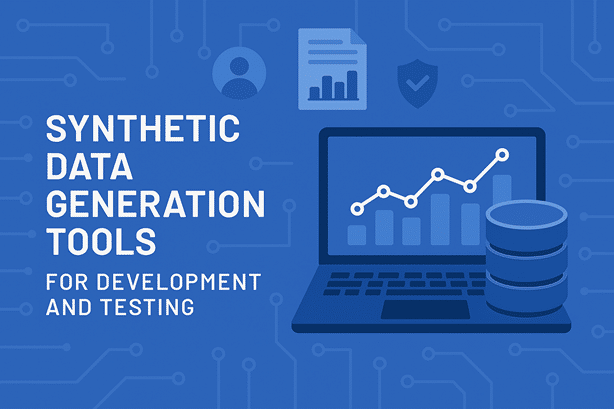
In software development and testing, having access to high-quality, realistic data is crucial. But real production data is often sensitive, regulated, or simply unavailable for testing purposes.
Synthetic data generation tools provide a powerful alternative, enabling teams to create artificial datasets that mimic real data while ensuring privacy and compliance.
This guide walks through key considerations for choosing a synthetic data tool, highlights essential features, and reviews seven leading tools in the space. Plus, we’ll explore how Enov8’s vME solution helps govern synthetic data across environments for enterprise compliance.
So welcome to the simulation, and stay tuned if you want practical tips on making your fake data as real as possible.
Why Use Synthetic Data in Development and Testing?
Using synthetic data allows developers and testers to simulate real-world scenarios without risking exposure of sensitive customer or business information. This approach accelerates testing cycles, supports privacy regulations like GDPR and CCPA, and enables testing of edge cases that may be rare or difficult to reproduce with real data.
Synthetic data also supports continuous integration/continuous deployment (CI/CD) pipelines by providing stable, reusable datasets.
How to Choose a Synthetic Data Generation Tool
Selecting the right synthetic data tool depends on your specific needs.
Consider whether you require solutions tailored for tabular data, images, text, or time series. Evaluate if the tool integrates easily into your existing development and testing workflows, and whether it supports compliance needs like data masking, anonymization, and audit trails.

5 Key Features to Look For
So what should you look for in a data generation tool? Here are some key concerns.
- Data fidelity: The synthetic data should closely resemble real data in distribution and relationships.
- Scalability: Ability to generate large volumes of data quickly for performance testing.
- Compliance & Governance: Features that support regulatory compliance and enable governance policies.
- Integration: APIs or connectors to plug into existing DevOps and testing pipelines.
- Customizability: Options to customize data generation based on domain-specific rules or scenarios.
Enterprise and Compliance Considerations
Enterprises face additional challenges around data governance, auditability, and compliance when using synthetic data. It’s important to choose tools that offer traceability and support data privacy laws. Solutions that integrate governance across multiple environments can reduce risk and increase trust in testing outputs.
7 Synthetic Data Generation Tools for Dev & Testing
1. Tonic.AI
Tonic.ai generates high-quality synthetic data that maintains referential integrity and complex relationships. It supports a wide variety of data sources and integrates seamlessly into testing pipelines. Its strong compliance features make it a solid choice for enterprises.
Pros: Excellent data realism, easy integration, strong compliance support.
Limitations: Pricing may be high for smaller teams.
2. Mostly AI
Mostly AI focuses on privacy-first synthetic data generation, using AI-driven models to anonymize and mimic real data. It is known for easy deployment and strong regulatory compliance.
Pros: Privacy-centric, user-friendly interface, compliant with GDPR and HIPAA.
Limitations: May require training for advanced customizations.
3. Gretel.ai
Gretel.ai offers synthetic data APIs that enable developers to generate, transform, and protect data at scale. It emphasizes developer-centric tooling and flexibility.
Pros: Developer-friendly APIs, flexible use cases, scalable.
Limitations: Less turnkey for non-developers.
4. Synthea
Synthea is an open-source synthetic patient data generator widely used in healthcare testing. It creates realistic healthcare records for research and testing without privacy concerns.
Pros: Open source, healthcare-specific, customizable scenarios.
Limitations: Niche focus, less suited for non-healthcare data.
5. YData
YData combines synthetic data generation with data augmentation capabilities. It supports tabular and time series data with advanced AI models.
Pros: Advanced AI models, supports time series, data augmentation.
Limitations: Newer player, smaller user community.
6. DataProf
DataProf is a synthetic data generation platform designed to help teams create high-quality, privacy-compliant datasets for testing and development. It uses advanced algorithms to ensure synthetic data retains the statistical properties of real data while protecting sensitive information.
DataProf supports easy integration with existing workflows and emphasizes user-friendly tools for both developers and data teams.
Pros: Privacy-focused, good data fidelity, integrates well with testing pipelines.
Limitations: Newer platform with a smaller user base compared to some incumbents.
7. Mockaroo
Mockaroo is a popular, easy-to-use online tool for generating realistic sample data quickly. It’s well suited for smaller-scale dev/test use cases.
Pros: User-friendly, customizable schemas, free tier available.
Limitations: Limited enterprise features and governance.
How to Govern Synthetic Data Across Environments
Managing synthetic data across diverse development and testing environments requires a deliberate approach to governance that balances flexibility with control. As teams generate synthetic datasets tailored to different projects, it becomes easy for data to become inconsistent or fragmented if there isn’t a centralized strategy in place.
Without governance, these variations can lead to unreliable test outcomes or integration issues that undermine the value of synthetic data altogether.
A key aspect of governance is controlling access to synthetic data. Even though this data is artificially generated, it often retains sensitive qualities derived from production data. Ensuring that only authorized individuals or teams can create, modify, or access these datasets is critical for maintaining privacy and adhering to compliance requirements.
Proper governance frameworks establish role-based permissions and safeguard synthetic data from misuse or accidental exposure, reinforcing organizational trust in testing environments.

Traceability and auditability also play vital roles in synthetic data governance. Enterprises must be able to track when and how synthetic datasets are created, modified, or shared across environments. This data lineage supports regulatory compliance by providing clear records for audits, while also enhancing internal accountability. Knowing the provenance of datasets helps teams quickly identify the source of any anomalies or issues that arise during testing, enabling more effective troubleshooting and continuous improvement.
Lastly, synthetic data governance ensures that data remains relevant and accurate throughout the software development lifecycle. As applications evolve, so too must the synthetic datasets used for testing. Without proper version control and policy enforcement, teams risk working with outdated or improperly masked data, which can compromise the integrity of testing efforts.
Governance mechanisms that integrate automated policy enforcement and version management help maintain data quality and regulatory alignment over time, ultimately empowering teams to develop and deploy software with greater confidence.
Why Governance Matters
Governance is a foundational element when it comes to managing synthetic data in enterprise environments.
Even though synthetic data is artificially generated, it often mirrors the structure and sensitive characteristics of real data, which means that without proper controls, it can still pose privacy and compliance risks. Organizations that neglect governance risk exposing confidential information inadvertently or falling out of compliance with regulations like GDPR, HIPAA, or CCPA. This can lead to significant legal liabilities and damage to reputation.
Beyond compliance, governance ensures that synthetic data remains reliable and consistent across multiple teams and environments. In large organizations, different departments might generate their own synthetic datasets tailored to their unique testing needs.

Without oversight, this can result in fragmented data that varies in quality and format, making it difficult to trust test results or compare outcomes across projects. Governance establishes a framework to maintain data quality and uniformity, which is critical to ensure that synthetic data accurately reflects the conditions it is meant to simulate.
Furthermore, governance creates accountability and transparency. Tracking the lifecycle of synthetic data—how it was generated, who accessed it, and what transformations it has undergone—enables organizations to audit their data practices rigorously.
This traceability is essential not only for regulatory audits but also for internal quality assurance, helping teams identify and resolve issues quickly. Effective governance policies empower organizations to manage risk proactively, supporting secure and compliant synthetic data use that ultimately accelerates development cycles and improves product quality.
How Enov8 vME Supports Synthetic Data Strategy
Enov8’s vME platform provides enterprise-grade test data management with built-in governance capabilities. It helps orchestrate synthetic data workflows, enforces compliance policies, and offers visibility across all test environments. This centralized approach reduces risk and improves the efficiency of your testing lifecycle.
Final Thoughts on Choosing the Right Tool
Selecting a synthetic data generation tool depends on your team’s needs, regulatory environment, and integration requirements. Consider tools that balance data fidelity, scalability, and compliance features.
And remember, effective governance across environments is key — which is where solutions like Enov8 vME deliver real value. Download the Enov8 TDM InBrief PDF if you’d like to read more.

